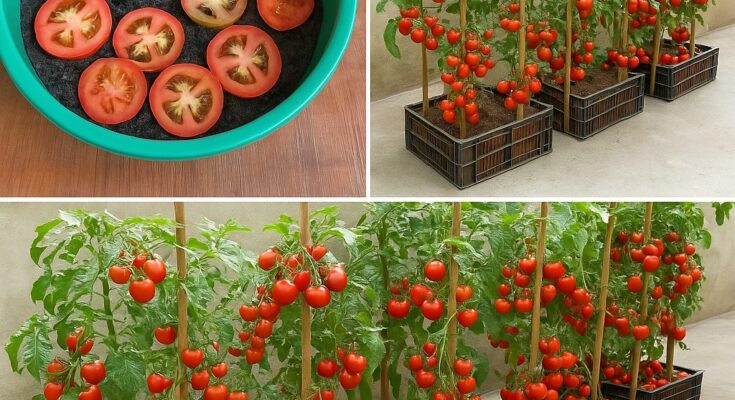How to Grow Tomatoes at Home for High Yield – No Need for a Garden
Tomatoes are a beloved and versatile fruit that can be used in a wide range of dishes. Growing tomatoes at home is not only rewarding but also cost-effective. Even if you don’t have a garden, you can still enjoy fresh, homegrown tomatoes by using creative and space-saving methods. This article will guide you through the process of growing tomatoes at home, ensuring a high yield even in small spaces.
Why Grow Tomatoes at Home?
There are several benefits to growing tomatoes at home:
-
Freshness: Homegrown tomatoes are fresher, tastier, and healthier than store-bought varieties.
-
Cost-Effective: Growing your own tomatoes can save money in the long run, especially during peak tomato seasons.
-
-
-
Convenience: Having tomatoes right at your doorstep means you can easily pick them when needed, reducing waste and ensuring that you always have them on hand.
-
-
Sustainability: By growing your own tomatoes, you reduce your carbon footprint and contribute to a more sustainable lifestyle.
With the right approach, even those without a traditional garden can enjoy the pleasure of homegrown tomatoes.
-
-
Materials You’ll Need
Before you start, gather the following supplies:
-
Tomato seeds or young tomato seedlings
-
Containers (such as plastic bottles, buckets, or large pots)
-
Well-draining potting soil
-
Fertilizer (organic or synthetic)
-
Stakes or cages (for support)
-
Watering can or hose
-
-
-
A sunny spot (windowsill, balcony, or patio)
-
-
Compost (optional, for enriching the soil)
Step-by-Step Guide to Growing Tomatoes at Home
1. Choose the Right Tomato Variety
Selecting the right tomato variety is crucial to ensuring a high yield. There are two main types of tomatoes to consider:
-
Determinate tomatoes: These tomatoes grow to a certain height and then stop, producing fruit all at once. They are compact and ideal for containers and small spaces.
-
Indeterminate tomatoes: These tomatoes continue growing and producing fruit throughout the growing season. They need more space and support but offer a larger yield over time.
For smaller spaces, determinate varieties like “Tiny Tim,” “Patio Princess,” or “Bush Early Girl” are excellent choices.
2. Prepare Your Containers
Tomatoes need space for their roots to grow, so choose containers that are at least 12-18 inches deep. Plastic bottles, buckets, large pots, or even repurposed containers can work well for growing tomatoes. If you’re using plastic bottles, be sure to cut them in half or make a large hole in the side to create adequate space for the plant to grow.
Be sure that your containers have drainage holes to prevent waterlogging, which can lead to root rot.
3. Prepare the Soil
Tomatoes thrive in well-draining soil that is rich in organic matter. Use a good quality potting mix, and consider adding compost or organic fertilizer to enrich the soil. This will provide the necessary nutrients to ensure healthy growth and a high yield. Avoid using garden soil, as it may not drain well in containers.
Fill your containers with the prepared soil, leaving a few inches at the top to allow for watering.
4. Planting the Tomatoes
Tomato plants can be started from seeds or young seedlings. If you’re starting from seeds, plant them indoors 6-8 weeks before the last frost date. Once the seedlings have developed a few sets of leaves and the weather is warm, you can transplant them into your containers.
Plant your tomatoes deep—bury the seedlings up to the first set of leaves. Tomatoes can develop roots along their stems, so burying them deeply encourages a stronger root system, leading to healthier plants.
5. Provide Support for the Plants
Tomato plants, especially indeterminate varieties, require support as they grow. Use stakes, cages, or trellises to keep the plants upright and prevent the stems from breaking under the weight of the fruit. Secure the plants to the support structures as they grow, using soft ties to avoid damaging the stems.
For container-grown tomatoes, be sure the support structure is tall enough to accommodate the growth of the plant.
6. Watering and Care
Tomatoes require consistent watering to grow well. However, it’s important not to overwater, as soggy soil can lead to root rot. Water the plants deeply, allowing the soil to dry out slightly between waterings. Tomatoes generally need about 1-1.5 inches of water per week, but this may vary depending on the weather and container size.
Be sure to water at the base of the plant rather than from above to prevent moisture on the leaves, which can encourage fungal diseases. Using a watering can or drip irrigation system can help direct water to the roots.
7. Fertilizing Your Tomato Plants
Tomatoes are heavy feeders, so it’s essential to fertilize them regularly. Use a balanced fertilizer that is rich in nitrogen, phosphorus, and potassium. Organic compost is an excellent option for providing a slow release of nutrients.
Fertilize the plants every 2-3 weeks during the growing season, following the manufacturer’s instructions for the type of fertilizer you’re using. Be careful not to over-fertilize, as this can lead to excessive foliage growth and fewer fruits.
8. Harvesting Tomatoes
Tomatoes will be ready to harvest once they have fully ripened and are vibrant in color. Depending on the variety, this could take anywhere from 50 to 85 days after planting. Gently twist or cut the tomatoes from the vine when they are fully ripe.
For indeterminate varieties, continue to harvest tomatoes as they ripen, and the plant will produce more fruit throughout the growing season.
Final Tips for High Yield
-
-
Pruning: Regularly remove suckers (small shoots that appear in the joint between the main stem and branches) to direct the plant’s energy into producing fruit instead of excess foliage.
-
-
Pest Control: Keep an eye out for pests such as aphids, whiteflies, and hornworms. If you notice any, treat the plants with organic pest control methods, such as neem oil or insecticidal soap.
-
Sunlight: Tomatoes need at least 6-8 hours of direct sunlight per day to thrive. Choose a sunny spot for your containers, such as a windowsill, balcony, or patio.
-
-



